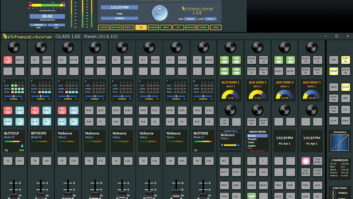
Sean Mattingly, director of technical operations for Woof-Boom Radio, found a great use for a restaurant kitchen ticket holder.
Shown in Fig. 1, kitchen tickets — or, in this case, your liner cards or weather forecast — can be slipped into the slot, held in place right in front of the talent, and changed just as easily.
The ticket holders are not expensive — a 48-inch model is less than $10 at the Webstaurant Store (webstaurantstore.com). Search “kitchen order ticket holder” on the website for a variety of styles and prices.
***
In our previous column, we talked about general transmitter troubleshooting and safety steps. Now, let’s focus on the transmitter tubes.
Tubes must be handled carefully. The tube operates in a vacuum. Sudden jarring or dropping the tube can crack the seal, compromising the vacuum. In glass tubes, a white coating will develop as the filament burns up. Dropping a tube can also loosen the support structures inside the tube.

If the components sag inside the tube, they could short to other elements. Element-to-element shorts, as well as an open filament, can all be diagnosed with an ohmmeter. Refer to the transmitter schematic or tube sheet, as seen in Fig. 2, to identify the pins.
Inspect the tube pins or terminals. Oxidation can cause intermittent operation. Burnish the contacts using crocus cloth to remove any oxidation.
Do not use sandpaper, as it will remove the gold or silver flash or plating. Sanding pins may also reduce the diameter of the pins, resulting in a loose fit.
Do not use Tarn-X on tube pins. Tarn-X is designed for precious metals and contains sulfuric acid. It’s not a friend of low-power nickel-steel tube pins.
In the days of tube-powered receivers, drug store tube checkers could diagnose receiving tube faults. In the case of transmitting tubes, substitution is your best ally. Having a supply of working spare tubes can help determine tube failure. Most new tubes work right out of the box, but this is not always the case. Don’t assume a tube is good simply because it is new. Duds may be rare, but they do occur.
Tube socket failure is also rare but does occur. Inspection with a strong light and ohmmeter — with the transmitter de-energized and all components grounded with the shorting stick — may help diagnose the problem.
Have you had some interesting tube or tube socket experiences? Share them with your fellow engineers using my email address below.
***
Broadcast engineer and problem solver Joe Stack really liked Mark Voris’ kitchen cabinet idea, discussed in the Jan. 1 Workbench.
Recall that Mark hid his station’s punchblocks inside a kitchen cabinet with doors, which kept the wiring out of sight. Since the cabinet was hung on the wall, he also eliminated the need to crawl under console furniture to make wiring changes.
Joe, too, has pressed common home products into service for broadcast use.
A colleague of Joe’s actually went to Home Depot and picked up a few toilet tissue holders that made ideal headphone holders. The tissue holders are the kind shaped in the form of the letter “C” and allow the tissue roll to slide on and slide off from the side. When Joe first saw them, he actually thought they were manufactured as headphone holders!
Mounted to the side, under the console, the headphones are within easy reach, yet out of sight when not in use. No more headphones on the floor or taking up space on the countertop.
***
Now, I said Joe Stack is a problem-solver. Drawn from his years of broadcast experience, Joe has developed a cleaning kit that you can order at kleenkit.com. When used along with suction from a vacuum cleaner, the KleenKit is an effective way to clean the insides of computer cases, equipment racks, exhaust fan assemblies and other surfaces that collect dust.
As other particles in the air collect with the dust, a hard layer is formed, making it almost impossible to be removed by suction alone. That’s when KleenKit’s brushing, air blasting and scraping actions come in handy.
The KleenKit includes a dust mask, a magnifying glass, a notebook and pencil, an air blaster squeeze bottle, a soft cleaning brush, an inspection mirror, a stiff bristle brush, a flashlight and batteries, wooden scraping sticks, an instruction sheet and a storage box to hold everything.
Although it was not designed specifically for transmitter cleaning, the kit has several components that certainly can be used for that purpose. At under $30, the KleenKit won’t break the bank, and it is suitable for the transmitter site, as well as the studio. They are available to order online.
Over the years, Joe has developed a number of problem-solving products. You can find out more at stackleydevices.com.
Contribute to Workbench. You’ll help your fellow engineer and qualify for SBE recertification credit. Send Workbench tips to [email protected]. Fax to (603) 472-4944.
Author John Bisset has spent 45 years in the broadcasting industry and is still learning. He handles West Coast sales for the Telos Alliance. He is SBE Certified and is a past recipient of the SBE’s Educator of the Year Award.












